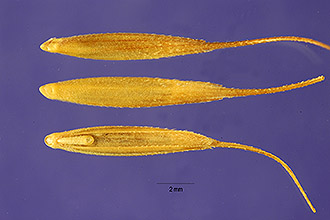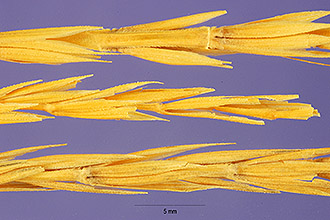Dahurian Wild Rye
Scientific Name: Elymus dahuricus Turcz. ex Griseb.

| General Information | |
|---|---|
| Usda Symbol | ELDA3 |
| Group | Monocot |
| Life Cycle | |
| Growth Habits | Graminoid |
| Native Locations | ELDA3 |
Plant Guide
Alternate Names
Common Names: None Scientific Names: None , Use soil moisture sensors to measure the soil moisture of Dahurian Wild Rye.
Description
General: Dahurian wildrye is an introduced, self-pollinating, short-lived (1-3 yrs) perennial bunchgrass with culms reaching 40 to 60 inches. The stems are leafy with leaves 11 to 18 mm wide and lax. The seed head forms a tight spike with 2 to 4 spikelets per node (Dobb and Burton 2013). There are approximately 80,000 seeds/lb. The root system is shallow and fibrous. Dahurian wildrye is similar in appearance to blue wildrye (E. glaucus) but differs in palea shape (Barkworth and others 1993). Distribution: Dahurian wildrye is native to Siberia, Mongolia and China. In North America it has been used in pasture and hay production in western Canada from Saskatchewan to British Columbia. Its use is limited in the northern Great Plains region of the United States (Alderson and Sharp 1994). For current distribution, please consult the Plant Profile page for this species on the PLANTS Web site. Habitat: This species has been used in North America on rangeland and for pasture and hay forage.
Adaptation
Dahurian wildrye is adapted to sites receiving 12 to 24 inches annual precipitation (Dobb and Burton 2013), but persists longer with higher precipitation. It is said to have high saline tolerance and is adapted to all soil textures (Dobb and Burton 2013). It was grown in test plots in Saskatchewan with electrical conductivity levels up to 6.7 dS/m (Glover and others 2004). It is not as winter hardy as crested or intermediate wheatgrass in semi-arid climates with little snow cover. It is very competitive during establishment but loses competitive ability as the stand ages.
Uses
Hay and pasture: Dahurian wildrye is a tall plant with leaves growing high up on the stem providing excellent forage for pasture. It also has better regrowth after harvest than intermediate and crested wheatgrass and can be grazed 2 to 3 times per season. It produces significantly greater amounts of forage than crested and intermediate wheatgrass in the first growing season but decreases as stands lose vigor in subsequent years (Lawrence and Ratzlaff 1988). Forage quality and palatability of Dahurian wildrye is high, comparable to intermediate and crested wheatgrass. Dahurian wildrye is a short-lived perennial with quick establishment and is used as an early forage component with other slower growing species. It should be limited in mixes to less than 25% to prevent it from outcompeting less vigorous species. Montana State University Extension (Dixon 2014) recommends the following mixes based on grazing seasons in south central Montana: Spring Pasture: 5 lb crested wheatgrass 0.5-1 lb alfalfa 1 lb Dahurian wildrye Summer Pasture: 6 lb western wheatgrass 1-2 lb white prairie clover or small burnet 1 lb Dahurian wildrye Fall pasture: 6 lb Russian wildrye 0.5-1 lb alfalfa 1 lb Dahurian wildrye Natural Resources Conservation Service Plant Guide Because it regrows quickly after harvesting it has a better yield distribution than other forage grasses.
Status
Please consult the PLANTS Web site (http://plants.usda.gov/) and your State Department of Natural Resources for this plant’s current status (e.g., threatened or endangered species, state noxious status, and wetland indicator values).
Planting Guidelines
The full stand seeding rate for Dahurian wildrye is 14 lbs/ac for a target of 25 seeds/ft². This species shows excellent emergence and seedling vigor, better than crested or intermediate wheatgrass and has established from deep seeding trials as deep as 1.5 in. Drill seeding to a depth of 0.5 to 0.75 inches is recommended (Lawrence and others 1991). Due to high seedling vigor and competition, Dahurian wildrye should be seeded in alternate rows or cross seeded perpendicular to slower establishing species such as Russian wildrye (Holt and Lawrence 1994). This will provide good forage while other species develop.
Management
Dahurian wildrye has exceptional grazing recovery (Dobb and Burton 2013). It can be grazed in early spring without negative effects. However Dahurian wildrye has a shallow root system and plants can be pulled easily from the ground in wet spring soils during the establishment year. New seedings should be protected from grazing until they are well established (Ogle and others 2011).
Pests and Potential Problems
There are no known pests or potential problems associated with Dahurian wildrye.
Environmental Concerns
Concerns
Concerns
This species is not native to North America and may spread via seed under ideal conditions. Its use however, has been limited to managed pastures. It is not noted for weedy tendencies. Dahurian wildrye is self-pollinating and will not form hybrids with native species (Lawrence and Ratzlaff 1988).
Seeds and Plant Production
Plant Production
Plant Production
Seed production for Dahurian wildrye is similar to that of other wildryes and wheatgrasses. Wide row spacing of 24 to 36 inches is recommended for mechanical weed control, however tighter row spacing of 12 inches provides higher yields. Seeders should be calibrated to deliver approximately 8 seeds per foot of row. For 12 inch spacing this equates to 4 lbs/ac. Fertilizer is not recommended during establishment but fall or early spring applications of nitrogen after establishment can increase yields. Seed can be harvested either with swathing or with direct combining. Seed heads can shatter seed even when the heads are still green. Seed yields on irrigated fields average 600 to 1050 lbs/ac, while dryland yields average 260 to 600 lbs/ac. Dahurian wildrye is self-pollinated, so minimal isolation distance is required for certified seed production. Cultivars, Improved, and Selected Materials (and area of origin) ‘Arthur’ and ‘James’ Dahurian wildrye were selected at Agriculture Canada Research Station in Saskatchewan in 1989 from collections made in China. Both were released for high establishment year yields compared to other wildryes. There are no distinguishing features which separate Arther from James Dahurian wildrye. Arthur heads slightly earlier than James (Sharp and Alderson 1994).
Literature Cited
Barkworth, M.E., Campbell, J.N., and Salomon, B. 1993. Elymus. In: Flora of North America Editorial Committee, eds. 1993+. Flora of North America North of Mexico. 16+ vols. New York and Oxford. Vol. 3, pp. 356-357. Dixon, P. 2014. Yellowstone County suggested dryland pasture seeding. Montana State University Extension. Billings, MT. http://www.co.yellowstone.mt.gov/extension/ag/pubs/dryseedpasture.pdf. Dobb, A., S. Burton. 2013. Rangeland Seeding Manual for British Columbia, B.C. Min. Agri., Sust. Agri. Mgmt. Br., Abbotsford, B.C. Glover, D.E., Kielly, G.A., Jefferson, P.G and R.D.H. Cohen. 2004. Agronomic characteristics and nutritive value of 11 grasses grown with irrigation on a saline soil in southwestern Saskatchewan. 2004. Canadian Journal of Plant Science. 84: 1037-1050. Holt, N.W. and T. Lawrence. 1994. Pasture production of Russian wild ryegrass alone or in mixtures with Dahurian wild ryegrass or slender wheatgrass. Canadian Journal of Plant Science. 74: 103-107. Lawrence, T.; Ratzlaff, C. D., 1988: An evaluation of dahurian wild ryegrass Elymus dahuricus Turcx ex Griseb as a forage crop. Forage Notes 33: 28-40 Lawrence, T, Ratzlaff, C.D and P.G. Peterson. 1991. Emergence of several Triticeae range grasses influenced by depth of seed placement. Journal of Range Management. 44(2): 186-187. Ogle, D., St. John, l. Stannard, M., Cornwell, J, Holzworth, L. 2011. Technical Note 10: Pasture and Range Seedings – Planning, Installation, Evaluation, Management. USDA-NRCS Boise, ID-Salt Lake City, UT-Spokane, WA. 35 p. Sharp, W.C. and J. Alderson. 1994. Grass Varieties in the United States. USDA-Soil Conservation Service, Ag. Handbook No. 170. 296p. Citation Tilley, D. and L. St. John. 2014. Plant Guide for Dahurian wildrye (Elymus dahuricus). USDA-Natural Resources
Conservation
District at http://www.nrcs.usda.gov/ and visit the PLANTS Web site at http://plants.usda.gov/ or the Plant Materials Program Web site: http://plant-materials.nrcs.usda.gov. PLANTS is not responsible for the content or availability of other Web sites.

